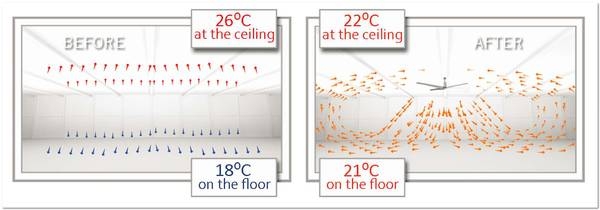Destratification creates more comfort and lower costs for plants throughout the entire year.
Large open workspaces are a hallmark of industrial and commercial facilities. Operations that include manufacturing, processing and warehousing need these wide-open areas for the specialized machinery and processes that allow them to be efficient. Unfortunately, the same floor plan that makes them efficient operationally also makes them inefficient from a heating and cooling standpoint.
Many plant managers attempt to address this problem by enhancing an existing system. For the most part, HVAC systems do an efficient job of providing heated or cooled air to specified areas of a building. However, while regular maintenance will keep an HVAC system running smoothly, it won’t optimize HVAC operation as much as the addition of a high-volume, low-speed (HVLS) fan network.
As one would assume, HVLS fans can play a significant role in helping to cool a facility. But even greater benefits can be seen during cold weather. Before looking at those benefits, though, let’s first examine how HVLS fans keep working areas cool and operating at maximum efficiency.
Summer breeze feels nice
Worker comfort is no trivial matter. Studies have repeatedly shown that workers who are physically uncomfortable become distracted and are more prone to making mistakes. This is particularly true in cases of extreme discomfort, as when heat fatigue, heat stroke and other types of heat stress strike.
That’s why HVLS fans are becoming increasingly common in industrial facilities across the nation. With or without air-conditioning, virtually any facility will benefit immensely from HVLS fans. In facilities that don’t possess air conditioning, the benefits of HVLS fans are most noticeable.
Although smaller, traditional floor-mounted fans can be helpful in limited spaces, their high wind speed and noise levels may cause problems and they use a relatively high amount of electricity. In comparison, HVLS fans use relatively little energy and provide a gentle, quiet breeze that is very comforting to workers. This calm wind has profound effects on the perceived temperature for workers.
According to the U.S. Department of Health and Human Services paper, “Workers in Hot Environments,” an air speed of two to three miles per hour creates an evaporative cooling sensation of seven to 8 degrees Fahrenheit. To put this in perspective, the effective temperature of an 38-degree warehouse environment can be dropped to 30 degrees by adding a fan moving air at three miles per hour. This cooling effect can make workers up to 35% more productive.
A large 24-foot diameter HVLS fan gently moves large volumes of air up to 22,000 square feet and replaces 15 to 30 floor fans. By mixing air, HVLS fans also help air-conditioning systems work more efficiently, allowing them to be operated at a set point up to five degrees higher.
Warming up with destratification
During the heating season, there is often more than a 20-degree difference between the floor and ceiling at most manufacturing plants and warehouses as a result of warm air (light) rising and cold air (heavy) settling. Typically, the air temperature will be one-half to one degree warmer for every foot in height. Heating systems must work hard for extended periods of time to maintain the temperature near the floor, or at the thermostat set point, wasting precious energy and dollars. The charts in Figure 1 illustrates this concept.
HVLS ceiling fans mitigate the rising heat effect by gently moving the warm air near the ceiling back down toward the floor where it is needed. The air reaches the floor below the fan where it then moves horizontally a few feet above the floor. The air eventually rises to the ceiling where it is cycled downward again. This mixing effect creates a much more uniform air temperature, with perhaps a single degree difference from floor to ceiling. Facilities equipped with HVLS fans lower the burden on the heating system, reduce energy consumption and save money.
Conventional high-speed ceiling fans do not have this effect. Although they have been used to help circulate air for many years, they are ineffective in moving the warm air from ceiling to floor. By quickly spreading airflow away from the fan, little—if any—of that air reaches people working at the ground level. Thus, in facilities with traditional ceiling fans, the full benefits of the HVAC system rarely are realized on the floor.
Saving energy and money
Because HVLS fans run so efficiently, their return on initial investment often ranges from as quickly as six months to two years. However, this varies due to application variables.
Valuable investment for any season
No matter the season or the temperature-controlled application, HVLS fans can provide numerous benefits. Not only will they enhance environmental control to help comfort workers and protect product, they do it by using less energy for less hassle than traditional high-speed floor fans.
Post time: Aug-23-2023



 Email:chenzhenxiang@optfan.com
Email:chenzhenxiang@optfan.com